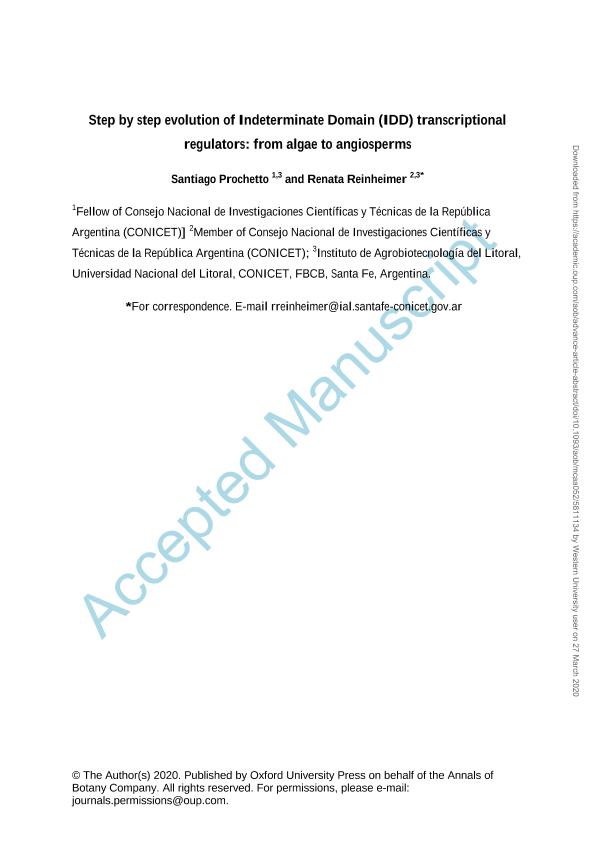Mostrar el registro sencillo del ítem
dc.contributor.author
Prochetto, Santiago

dc.contributor.author
Reinheimer, Renata

dc.date.available
2020-10-31T22:07:33Z
dc.date.issued
2020-06
dc.identifier.citation
Prochetto, Santiago; Reinheimer, Renata; Step by step evolution of Indeterminate Domain (IDD) transcriptional regulators: From algae to angiosperms; Oxford University Press; Annals of Botany; 126; 1; 6-2020; 85-101
dc.identifier.issn
0305-7364
dc.identifier.uri
http://hdl.handle.net/11336/117360
dc.description.abstract
Introduction: The Indeterminate Domain (IDD) proteins are a plant specific subclass of C2H2 Zinc Finger transcription factors. Some of these transcription factors play roles in diverse aspects of plant metabolism and development, however the function of most of IDD genes is unknown and the molecular evolution of the subfamily has not been explored in detail. Methods: In this study, we mined available genome sequences of green plants (Viridiplantae) to reconstruct the phylogeny and then described the motifs/expression patterns of IDD genes. Key results: We identified the complete set of IDD genes of 16 Streptophyta genomes. We found that IDD and its sister clade STOP arose by a duplication at the base of Streptophyta. Once on land, the IDD genes duplicated extensively, giving rise to at least ten lineages. Some of these lineages were lost in extant non-vascular plants and gymnosperms, however all of them were retained in angiosperms, duplicating profoundly in dicots and monocots and acquiring, at the same time, surprising heterogeneity in their C-terminal regions and expression patterns. Conclusions: IDD were present in the last common ancestor of Streptophyta. On land, IDD duplicated extensively originating ten lineages. Later, IDD were recruited by angiosperms where they diversified greatly in number; C-terminal and expression patterns accompanying important aspects of plant body evolution.This study provides a solid framework of the orthology relations of green land plant IDD transcription factors, thus increasing the accuracy of ortholog identification in model and non-model species and facilitating the identification of agronomically important genes related to plant metabolism and development.
dc.format
application/pdf
dc.language.iso
eng
dc.publisher
Oxford University Press

dc.rights
info:eu-repo/semantics/openAccess
dc.rights.uri
https://creativecommons.org/licenses/by-nc-sa/2.5/ar/
dc.subject
TRANSCRIPTION FACTOR
dc.subject
ZINC FINGER
dc.subject
DOMAIN DIVERSIFICATION
dc.subject
PHYLOGENETICS
dc.subject.classification
Ciencias de las Plantas, Botánica

dc.subject.classification
Ciencias Biológicas

dc.subject.classification
CIENCIAS NATURALES Y EXACTAS

dc.subject.classification
Biología

dc.subject.classification
Ciencias Biológicas

dc.subject.classification
CIENCIAS NATURALES Y EXACTAS

dc.title
Step by step evolution of Indeterminate Domain (IDD) transcriptional regulators: From algae to angiosperms
dc.type
info:eu-repo/semantics/article
dc.type
info:ar-repo/semantics/artículo
dc.type
info:eu-repo/semantics/publishedVersion
dc.date.updated
2020-09-25T19:06:00Z
dc.journal.volume
126
dc.journal.number
1
dc.journal.pagination
85-101
dc.journal.pais
Reino Unido

dc.description.fil
Fil: Prochetto, Santiago. Consejo Nacional de Investigaciones Científicas y Técnicas. Centro Científico Tecnológico Conicet - Santa Fe. Instituto de Agrobiotecnología del Litoral. Universidad Nacional del Litoral. Instituto de Agrobiotecnología del Litoral; Argentina
dc.description.fil
Fil: Reinheimer, Renata. Consejo Nacional de Investigaciones Científicas y Técnicas. Centro Científico Tecnológico Conicet - Santa Fe. Instituto de Agrobiotecnología del Litoral. Universidad Nacional del Litoral. Instituto de Agrobiotecnología del Litoral; Argentina
dc.journal.title
Annals of Botany

dc.relation.alternativeid
info:eu-repo/semantics/altIdentifier/url/https://academic.oup.com/aob/article/126/1/85/5811134
dc.relation.alternativeid
info:eu-repo/semantics/altIdentifier/doi/http://dx.doi.org/10.1093/aob/mcaa052
Archivos asociados
